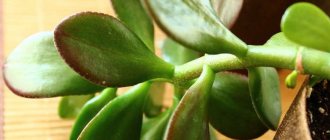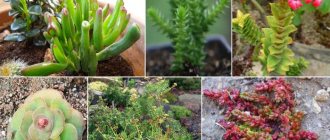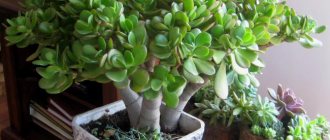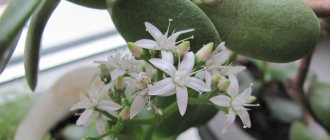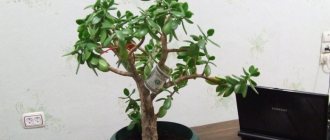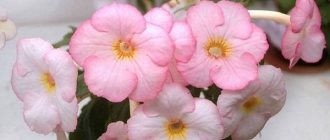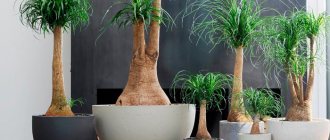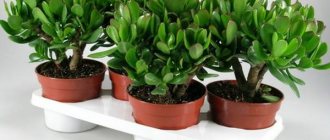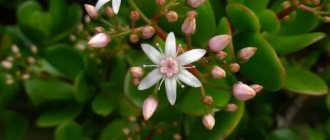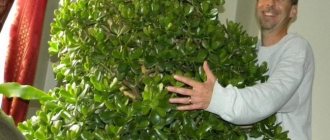Kalanchoe
Like the money tree, Kalanchoe belongs to the Crassulaceae family and is also a succulent. It cannot be said that these plants are very similar to each other in appearance, but they have a lot in common. Kalanchoe, like Crassula, has dense, juicy and fleshy leaves.
There are many types of Kalanchoe, some more similar to Crassula, others less so. There are plants with smooth leaves, and others covered with hairs. The shape and size of the leaves can also be different; the height of the plant, depending on the species, ranges from 10 cm to 2-3 m.
If Crassula is called the money tree, then Kalanchoe is the tree of life. This is a real home doctor; most often, a runny nose is treated with the help of Kalanchoe leaves.
The most persistent and picky ampelous indoor plants
If you want to decorate your house or apartment, you can purchase beautiful and unpretentious hanging indoor flowers. Plants take root not only indoors, but also outdoors: on the terrace, on the balcony, in the gazebo. To prevent flowers from losing their aesthetic qualities, they must be periodically pinched and dried leaves removed.
In total, there are 3 types of hanging plants:
- succulents;
- blooming;
- decorative deciduous.
Most of these species were brought from hot countries with dry climates, so the place for them must be carefully chosen. In order for plants to develop better, it is recommended to sometimes turn them towards the light.
Important! When the buds open, the plant only needs to be watered. There is no need to carry out other care procedures, otherwise the flower may stop developing.
Among the most persistent ampelous indoor plants are the following.
- Hoya carnosa. The fleshy leaves of this flower accumulate enough liquid, so Hoya carnosa can easily do without water for 2-3 months. When providing normal lighting, watering and fertilizing, beautiful umbrella flowers appear on the plant.
- Chlorophytum. A simple and unpretentious flower survives even with minimal amounts of light and water. But in order for chlorophytum to bloom, it needs to be looked after more carefully: water it every 12 days, feed it 2 times a month, and spray it with water. The last procedure is best done regularly.
- Fuchsia ampelous. At the edges of the stems there are bright single-color and sometimes two-color flowers that form real cascades. Flowering lasts about 6-7 months, so this plant is popular. In addition, ampelous fuchsia does not require careful care: it grows well both in partial shade and on an open balcony.
- Tradescantia. The evergreen plant pleases its owners with beautiful flowers that have different shapes: lanceolate, oval, elliptical. Thick leaves grow alternately and are distinguished by bright shades: purple, pink, emerald. Tradescantia also does not require special care; it does well on eastern and southern windows.
Ficus
Ficus trees are popular houseplants that attract flower lovers with their powerful, glossy leaves. This flower is hard not to notice; once in a room, it immediately becomes an important part of the interior. It is united with the Crassula by thick, lacquered leaves.
In nature, ficuses grow in the tropical zone, so in temperate climates they are grown exclusively in heated rooms and greenhouses.
Popular house ficuses:
- Rubbery. It is similar to Crassula with its dense, leathery leaves. But the differences are hard to miss. The leaves of the ficus are huge - up to 20-30 cm in length, while the leaves of the ficus are the size of a coin. The color of the leaves is also different - in ficus they are much darker.
- Benjamin. This ficus is similar to the Crassula in its silhouette - it also looks like a small tree from afar. The ficus has a woody trunk, just like the fat plant. But plants can be easily distinguished by the shape of the leaves - those of the ficus are pointed and much thinner than those of the fat plant. In nature, this ficus grows up to 25 m in height, and at home up to 2-3 m.
The most unpretentious plants with fleshy leaves
Among the 1,500 species of plants with fleshy leaves, there are some that grow well indoors and do not require special care.
- Adenium. The flower resembles a tree, the height of which reaches 65 cm. Thanks to the fleshy leaves and trunk, which store moisture, the plant develops well and does not require constant watering. Adenium can be placed on the east or south side of the room. When the time comes to bloom, the branches are covered with flowers reminiscent of white lilies and light pink roses.
- Blooming Kalanchoe. The plant feels great on the east and west sides. It tolerates a lack of moisture more easily than humidity and shade, so Kalanchoe needs to be watered once a month. In order for it to bloom profusely, it must be provided with fertilizing, but overfeeding the plant is strictly prohibited, especially in the cold season.
- Spathiphyllum (“female happiness”). This indoor flower is unpretentious; it tolerates lack of light and humidity. If you notice that the leaves have begun to dry out, simply pour cool water over the plant. After this procedure, the flower will continue to grow normally and, moreover, beautiful white flowers, similar to calla lilies, will appear on it.
- Decembrist. This plant grows very quickly, which is why gardeners love it most. Breeders annually develop new varieties and species. In 1 year, the Decembrist can bloom 3 times, if, of course, it is provided with diffused light and regular watering (there is no need to constantly water, only when the top layer of the earth dries out).
- Balsam. This unpretentious plant annually pleases its owners with beautiful flowers. To ensure long-term flowering, balsam should be left in a brightly lit place for several hours. If you notice that the flower is dropping its lower leaves, then it needs to be watered.
- Money Tree. This is how the plant is popularly called; its scientific name is Crassula. This flower can really decorate any interior. Its thick trunk with numerous leaves reaches a meter in height. Crassula is unpretentious to temperature: in summer the flower needs 20-24 degrees of heat, and in winter - +16 °C. In spring, the money tree can be taken out onto the balcony, and the flower grows well on south and south-east windows. Many people believe that Crassula helps you get rich and attracts good luck to your home. But you need to know that its leaves contain arsenic, which is hazardous to health. Therefore, there is no need to grow this plant at home; 1 pot of flower is enough.
- "Stone Rose" This beautiful plant can most often be seen in flower beds, but it also does well at home. The name of this flower is translated from Greek as “eternally alive”: it tolerates dry climates and bright light well. If you grow this plant, it needs to be provided with good lighting, so install several lamps in the room if necessary.
- Indoor bryophyllum. Until recently, flower growers believed that bryophyllum belonged to the genus Kalanchoe, but it turned out that the plant is an independent variety of Crassulaceae. In indoor conditions, the height of the stem can reach one and a half meters in height, and in nature - 11 m. The flower is distinguished by large leaves with carved edges. Bryophyllum is also called “viviparous” because it multiplies quickly.
Euro wood
Zamioculcas, dollar or euro tree are a worthy alternative to Crassula. Like the money tree, this plant is associated with money and wealth.
Zamioculcas has a lot in common with the Crassula:
- The stems of both plants are thick;
- the leaves are dense and fleshy, but on the euro tree they are more elongated and less juicy;
- both succulents do not require watering;
- always beautiful, evergreen, they rarely bloom, but they are spectacular even without flowers;
- toxicity - both plants are poisonous, but when working with zamioculcas you need to wear gloves because of the burning juice.
Unlike the crassula, the euro tree has a tuberous root.
Zamioculcas looks more stylish and laconic than the Crassula, so it fits perfectly into commercial interiors - this plant today can often be seen in the offices of large companies, banks, and other reputable institutions.
Aeonium
Aeoniums are beautiful succulents and bright representatives of the Tolstyankov family. They have leaves very similar to the money tree, they are also unpretentious and tenacious. The main difference between plants is the arrangement of leaves.
Aeoniums, unlike Crassula, have leaves arranged in rosettes of different shapes. The money tree has all the leaves of the same green color, while the leaves of the aeoniums have a varied range of shades - the green color can have a variety of undertones, from pink to deep black.
Apthenia
This creeping South African plant is a succulent, but, unlike them, it can bloom brightly and wildly. But this does not prevent it from being as hardy as the money tree and other succulents. Aptenia belongs to the small Aizov family.
The leaves of Aptenia are similar to Crassula; they are just as dense, fleshy, and glossy. But their shape is different - they look like hearts, and the color is juicy, bright green. Aptenia leaves are densely arranged on thick stems. The name of the plant translates as “a flower that opens its petals at noon.”
Peperomia
Peperomia is a large genus of perennial herbs from the Pepper family. About 1000 species are found in nature, and about 30 peperomia are grown at home. This plant is similar to Crassula in its dense, rounded leaves and thick stems. The plant is native to the arid regions of South Africa.
The main difference between peperomia and money tree is not its external features, but its ability to survive. This plant is less hardy. It is especially demanding regarding light - it must be diffused, and watering - they need not abundant, but regular moisture.
Growing, planting and care at home
To ensure proper care of a bulbous flower, you need:
- water in the morning and daytime 2-3 times a week, and if the plant is visible dying, reduce it to a minimum;
- use a mineral dose of the substrate, fertilize with natural fertilizers;
- monitor the air humidity and temperature in the room: from +20 to +25 °C - in summer, in winter - from +10 to +14 °C;
- remember that bulbous crops are accustomed to bright light, so you need to place flowers closer to the sun’s rays;
- propagation is carried out by seeds, bulbs, and for some species by cuttings.
More information about the conditions for keeping bulbous crops can be found here.
The information will be useful to florists who dream of choosing one or another bulbous crop for planting. If you follow all the rules of care and familiarize yourself with the characteristics of each plant, you can purchase any flower and safely grow it.
Portulacaria
This is a perennial evergreen plant from the Portulaca family. Originally from South Africa. In nature, it grows as a shrub or low tree. In appearance, the plant is very similar to Crassula - with its fleshy, rounded leaves and woody trunk.
Portulacaria is often called the elephant bush, apparently due to the thickness of its branches and trunk. The plant looks extremely exotic - it looks like a miniature tree even more than the Crassula.
Aichrizon
This succulent, like Crassula, belongs to the Tolstyankov family. Aichrizon is an evergreen plant with dense, fleshy leaves and a thick stem. It is highly branched, and the green leaves, unlike the Crassula, can have yellow, red and white splashes.
Aichrizon is popularly known as the “tree of happiness and love.” It was named so for its leaves, which are shaped like stylized hearts. This succulent looks extremely decorative and fits organically into the most stylish interiors.
Catalog with descriptions of plants
Next, we list the most prominent representatives with descriptions, photos and names of home crops.
Amaryllis
Amaryllis (lat. Amaryllis) is one of the most common representatives of the Amaryllis family. The indoor plant is a flowering plant with an elongated stem and wide leaves, reaching up to 60 cm in size. The bulb is pear-shaped, characterized by an abundant peduncle (from 6 to 12 buds of various colors).
You can learn more about amaryllis varieties for home growing here.
Eucomis
The next type of bulbous plant, Eucomis, is distributed in the wild throughout South Africa. This culture is a representative of the Asparagus family. The plant got its name because of the interesting appearance of the flowers, reminiscent of thick hair (translated from Greek it means “beautiful-haired”). It has a long stem with many bulbs growing from the root.
Lily
Lily (lat. Lílium) is a representative of the Liliaceae (as the name itself explains). The stem reaches 15 - 20 cm in height, and the bulb is equipped with many lower leaves. The indoor flower looks like a bud, similar in appearance to a bowl or funnel.
You will find more information about domestic lilies in this section.
Pancratium beautiful
This plant is another species of the Amaryllis family. Pancratium speciosum is native to South and Central America. The culture has an oblong bulb reaching 12 cm in size, as well as a tall stem with narrow leaves. The bud is similar in shape to a lily, but has sparser and separated tongues.
Albuka
Albuca (lat. Albuca spiralis) belongs to the Asparagus family. A distinctive feature of flowering is the presence of a bulb that grows into the ground no more than half its height. The plant has a long, thick stem bearing white or yellow buds surrounded by a tangle of curly leaves.
Read about spiral albuca and its care in the apartment here.
Hippeastrum
The flower belongs to the Amaryllis family. Hippeastrum has a round (less often conical) bulb with a narrow stem and bright funnel-shaped buds with wide leaves.
Scadoxus multiflorus
Scadoxus multiflorus (lat. Scadoxus multiflorus) is another species of Amaryllis. The plant has become widespread in South Africa. The main feature of this flower is the presence of a “pseudo-stem” - a structure of petals tightly adjacent to each other, which are usually bright red in color. The bulb has a well-developed root system.
Hyacinth
Hyacinth (Hyacínthus) is a member of the Asparagus family. Plant bulbs are prolific: they are capable of producing flowering shoots for several years to come. The stems reach different lengths and heights, so they can be either long or short. Numerous small buds with sharp tips grow from wide leaves.
You can learn more about indoor hyacinths in this section.
Krinum
Crinum (lat. Crinum) refers to Amaryllis. It has a bulb with an elongated or short neck, a very long stem thickened towards the bottom with wide open bud tubes.
Ipheion uniflorum
Belongs to the Liliaceae family. Indeed, the appearance is very reminiscent of the main representative of this genus. Ipheion uniflorum has an ovoid bulb capable of producing several flower stalks in a large number of varieties. Buds of pastel shades (usually white or lilac), shaped like stars.
Hemanthus
Hemanthus (lat. Haemantus) belongs to the Amaryllis family. The plant is distinguished by convex spherical buds and dense round leaves.
Read about caring for hemanthus here.
Boevia climbing
This culture belongs to the Asparagus family. The peculiarity of the indoor flower is the presence of a spherical bulb, almost densely located on top of the soil base. Bowiea volubilis is a herbaceous plant with curly leaves that subsequently die off or turn into parts of the peduncle.
Freesia
Freesia (lat. Freesia) is the first representative of the Iris family in this article with large buds and wide arrow-shaped leaves. Within a year, the stem of these plants can reach a length of one meter.
Eucharis
It is a genus of the Amaryllis family. The height of the stem of Eucharis reaches 35 - 40 cm, the leaves and flowers have a semi-oval appearance.
More information about Eucharis can be found in this article.
Lachenalia aeloides
Lachenalia aloides (lat. Lachenalia aloides) belongs to the Asparagus family. The culture has a thin stem on which there are bright yellow flowers with long leaves in the shape of a rosette, reaching a length of 20 cm. The bulb is completely placed in the soil.
Clivia
Another representative of the large Amaryllis family. It is noteworthy that in Clivia there is no stem, and instead the bud consists of a large number of inflorescences formed by the leaves of the plant.
You can find information about the varieties and care of indoor clivia here.
Worsley
Worsleya (lat. Worsleya) is also classified as Amaryllis. The inflorescences of a lilac or blue hue have a large bulb, a tall stem, growing up to one and a half meters. The leaves of the flowers are quite narrow; The shape resembles that of an asterisk.
Zephyranthes
Previously belonged to the Liliaceae family, later became a representative of the Amaryllis family. Zephyrantes has a small bulb and a long peduncle. The leaves are arrow-shaped.
Rodofiala
Rhodophiala (lat. Rhodophiala) is a species of Amaryllis. It is used quite rarely as an indoor flower, but is a widespread crop in the countries of Chile and Argentina. The red buds have long umbrella petals 30–50 cm long. The plant is perennial, so the bulb does not require special care.
Oxalis or oxalis
Oxalis (Oxalis) is the main representative of the Oxalis family. The dark burgundy flowers have triple, triangle-shaped leaves.
Read about oxalis varieties that can be grown in a pot in this article.
Weltheimia
Veltheimia (lat. Veltheimia) is a species of Hyacinth. Habitat: coast and mountainous areas of South Africa. Rosette leaves grow at the base, and tube buds in shades of pink are located on a long stem. The bulb reaches a diameter of 7 cm.
Drimiopsis
The culture belongs to the Asparagus genus. Drimiopsis (Drimiopsis) is distinguished by the presence of a continuous row of thick and wide dark green leaves. Small white or lilac flowers are collected in a brush.
More information about drimiopsis can be found here.
Sprekelia or Sprekelia
Sprekelia (lat. Sprekelia) is classified as a member of the Amaryllis family. The round bulb reaches 5 cm in diameter, and the buds have an arrow-shaped appearance with curved long petals. As a rule, the plant has a red or burgundy tint.
Indian onion
Indian onion (Ornithogalum caudatum) is a representative of the Liliaceae. It has a convex bulb and long basal leaves reaching a length of 100 cm.
Read about the beneficial properties of Indian onions and their use in everyday life in this article.
Calla or zantedeschia
Calla or zantedeschia (lat. Zantedeschia) belongs to the Araceae family. It is distinguished by wide basal leaf plates and a narrow funnel-shaped flower of various shades.
Narcissus
It is a prominent representative of the Amaryllidaceae. Narcissus (Narcissus) abounds in all kinds of basal leaves; the buds are similar in shape to other representatives of this family (for example, vorsley).
Find out what varieties of narcissus can be grown in a pot here.
Hymenocallis
Hymenocallis (lat. Hymenocallis) also refers to Amaryllis crops. It has leaves pointed towards the top, growing from a thin stem. The inflorescences are shield-shaped and usually white. The bulb is distinguished by its small size and thin roots.
Valotta
Valotta is another Amaryllis fruit. The buds, grown from a bulb on a thick stem, have a bright red hue. The appearance of the flower is close to a lily.
Amarkrinum
Amarchrinum (lat. Amarchrinum) also belongs to the Amaryllidaceae. The plant is a hybrid of amaryllis and crinum. Therefore, it takes on the shape of a bud and leaves from the latter, and from amaryllis a thick stem and pear-shaped root crop. It has a beautiful mixture of white and pink shade.
Gloriosa
Gloriosa is a genus of the Colchicum family. They are distinguished by leafy shoots and bright two-color wave-shaped buds.
You will find information about the unusual flower in this article.
Scylla or ledeburia
Ledeburia or Scilla (lat. Ledebouria - Scilla) belongs to the Asparagus family. The colors of the long and thick leaves, which have various inclusions, are original.
Pachyphytum
This plant has the thickest leaves of any succulent. In some species they look like slightly flattened spheres. Pachyphytum comes from Mexico and belongs to the Tolstyankov family. The plant is alpine, grows at an altitude of 0.6-1.5 km.
In nature, pachyphytum is an evergreen shrub that grows up to 0.5 m in height. The stem is sparsely branched, and the leaves are without petioles - they are collected in rosettes located at the tips of the branches.
The name pachyphytum is formed from two Greek words - “pachy” (thick) and “phytum” (leaf).
Hoya
Hoya is a genus of evergreen tropical plants, vines and shrubs, from the Kutrovaceae family. The most popular indoor species is Hoya fleshy. It is popularly known as wax ivy. Hoya resembles Crassula with dense leaves, fleshy and leathery. But its stem, unlike the Crassula, is thin and flexible.
But the main difference from the money tree is flowering. Hoya blooms almost non-stop - from spring to autumn. Its flowers are collected in inflorescences. The color can be different - there are countless varieties of hoya. The flowers are dense, glossy, and seem to be made of plastic.
Caring for Succulents
The most famous types of succulents: Kalanchoe, aloe, cactus, crassula.
These plants can be seen in almost every office or apartment. These flowers do not require special care; they can go without water for a long time, maintaining an attractive appearance. But minimal comfort is necessary for these plants.
Lighting
Succulents are found in arid climates where the sun shines brightly, so at home the flowers need to be provided with good lighting. Experts recommend placing pots with plants on south, east and west windows (preferably installed on the south side). But we also must not forget that not all succulents like bright light; some of them cannot tolerate direct sunlight. Agave and cacti love the sun the most, but aloe and crassula can dry out due to too much light. The last two types should be shaded with something and placed on the eastern windows.
In the cold season, plants need 12-14 hours of daylight, so in the evening you need to turn on the light bulb, which should be installed at a height of 35 cm from the flower. Only when choosing lamps, give preference to a special phytolamp, thanks to which the plant will receive enough bright light. Luminescent ones do not heat up enough and reduce the intensity of light emission.
Air
In order for flowers to develop normally, they need sufficient air. The roots of succulents need air most of all, so for such flora you need to purchase loose, rocky soil. Succulents react normally to drafts, but in the hot season they need to be planted in a flower bed or simply take pots of flowers out onto the terrace or veranda.
Experienced gardeners recommend periodically spraying plants.
Watering
Since succulents originally grew in hot climates, excess moisture should not be allowed. Constant watering is more destructive for these plants than lack of water, so they need to be watered moderately and carefully.
When the succulents actively develop and bloom (blooming occurs from late spring to early autumn), watering should be done in small portions 1-2 times every 7-8 days. The rest of the time, plants need to be watered once every 9-12 days.
In winter, care must be taken when watering. It is enough to pour water into the pots once a month.
Temperature
During the flowering period in summer, succulents need a temperature of +26...+32 °C during the day, and +16...+22 °C at night. In winter, spring and autumn, +16...+20 °C during the day, and +6...+7 °C at night will be enough for them.
Fertilizers
Succulents, of course, are unpretentious, but they, like other plants, need periodic feeding. Beginning gardeners should remember that these indoor flowers cannot be fed with organic fertilizers, as they will cause the roots to rot. It is better to purchase special mineral substrates that contain useful elements. Professionals recommend using the highest quality fertilizers, for example, Agricola or Bona Forte. Thanks to their balanced composition, these products will help succulents develop fully.
During flowering, fertilizing should be done once every 35 days (in spring and summer). The rest of the time there is no need to feed the plants.
Dry feeding is not intended for succulents, so you need to apply an aqueous solution of the substrate under the root.
You can also purchase the biological product “Fitosporin M”. It contains useful components that stimulate plant growth. A special solution based on a biological product must be prepared 2.5 hours before use.
It is worth noting that you can feed succulents at home even without a special substrate. Nutrient fertilizer is made from wood ash. Just fill the substance with boiled water, keeping the proportions 1:3 and leave to brew for a day. The plants can be fed with the resulting mass 2 times in 30-40 days. If you decide to water flowers with ash, then this solution must be diluted with water (1:10).
Having learned which indoor plants with fleshy leaves are quite unpretentious, owners can safely purchase flowers and not spend a lot of time and effort caring for them.
